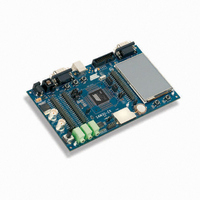ATSAM3U-EK Atmel, ATSAM3U-EK Datasheet - Page 1016

ATSAM3U-EK
Manufacturer Part Number
ATSAM3U-EK
Description
KIT EVAL FOR AT91SAM3U CORTEX
Manufacturer
Atmel
Type
MCUr
Datasheets
1.ATSAM3U-EK.pdf
(2 pages)
2.ATSAM3U-EK.pdf
(61 pages)
3.ATSAM3U-EK.pdf
(1171 pages)
4.ATSAM3U-EK.pdf
(53 pages)
Specifications of ATSAM3U-EK
Contents
Board
Processor To Be Evaluated
SAM3U
Data Bus Width
32 bit
Interface Type
RS-232, USB
Operating Supply Voltage
3 V
Silicon Manufacturer
Atmel
Core Architecture
ARM
Core Sub-architecture
Cortex - M3
Silicon Core Number
SAM3U4E
Silicon Family Name
SAM3U
Kit Contents
Board CD Docs
Rohs Compliant
Yes
For Use With/related Products
AT91SAM3U
Lead Free Status / RoHS Status
Lead free / RoHS Compliant
Available stocks
Company
Part Number
Manufacturer
Quantity
Price
Company:
Part Number:
ATSAM3U-EK
Manufacturer:
Atmel
Quantity:
10
- ATSAM3U-EK PDF datasheet
- ATSAM3U-EK PDF datasheet #2
- ATSAM3U-EK PDF datasheet #3
- ATSAM3U-EK PDF datasheet #4
- Current page: 1016 of 1171
- Download datasheet (25Mb)
1016
SAM3U Series
Buffer: A buffer of DMAC data. The amount of data (length) is determined by the flow controller.
For transfers between the DMAC and memory, a buffer is broken directly into a sequence of
AMBA bursts and AMBA single transfers.
For transfers between the DMAC and a non-memory peripheral, a buffer is broken into a
sequence of DMAC transactions (single and chunks). These are in turn broken into a sequence
of AMBA transfers.
Transaction: A basic unit of a DMAC transfer as determined by either the hardware or software
handshaking interface. A transaction is only relevant for transfers between the DMAC and a
source or destination peripheral if the source or destination peripheral is a non-memory device.
There are two types of transactions: single transfer and chunk transfer.
DMAC transfer: Software controls the number of buffers in a DMAC transfer. Once the DMAC
transfer has completed, then hardware within the DMAC disables the channel and can generate
an interrupt to signal the completion of the DMAC transfer. You can then re-program the channel
for a new DMAC transfer.
Single-buffer DMAC transfer: Consists of a single buffer.
Multi-buffer DMAC transfer: A DMAC transfer may consist of multiple DMAC buffers. Multi-buf-
fer DMAC transfers are supported through buffer chaining (linked list pointers), auto-reloading of
channel registers, and contiguous buffers. The source and destination can independently select
which method to use.
Channel locking: Software can program a channel to keep the AHB master interface by locking
the arbitration for the master bus interface for the duration of a DMAC transfer, buffer, or chunk.
Transfer
AMBA
Burst
Buffer
– Single transfer: The length of a single transaction is always 1 and is converted to a
– Chunk transfer: The length of a chunk is programmed into the DMAC. The chunk is
– Linked lists (buffer chaining) – A descriptor pointer (DSCR) points to the location
– Contiguous buffers – Where the address of the next buffer is selected to be a
single AMBA access.
then converted into a sequence of AHB access.DMAC executes each AMBA burst
transfer by performing incremental bursts that are no longer than 16 beats.
in system memory where the next linked list item (LLI) exists. The LLI is a set of
registers that describe the next buffer (buffer descriptor) and a descriptor pointer
register. The DMAC fetches the LLI at the beginning of every buffer when buffer
chaining is enabled.
continuation from the end of the previous buffer.
Transfer
AMBA
Burst
Buffer
HDMA Transfer
Transfer
AMBA
Burst
Buffer
Transfer
AMBA
Single
DMA Transfer
Level
Buffer Transfer
Level
AMBA Transfer
Level
6430D–ATARM–25-Mar-11
Related parts for ATSAM3U-EK
Image
Part Number
Description
Manufacturer
Datasheet
Request
R

Part Number:
Description:
AT91 ARM Thumb-based Microcontrollers
Manufacturer:
ATMEL [ATMEL Corporation]
Datasheet:

Part Number:
Description:
DEV KIT FOR AVR/AVR32
Manufacturer:
Atmel
Datasheet:

Part Number:
Description:
INTERVAL AND WIPE/WASH WIPER CONTROL IC WITH DELAY
Manufacturer:
ATMEL Corporation
Datasheet:

Part Number:
Description:
Low-Voltage Voice-Switched IC for Hands-Free Operation
Manufacturer:
ATMEL Corporation
Datasheet:

Part Number:
Description:
MONOLITHIC INTEGRATED FEATUREPHONE CIRCUIT
Manufacturer:
ATMEL Corporation
Datasheet:

Part Number:
Description:
AM-FM Receiver IC U4255BM-M
Manufacturer:
ATMEL Corporation
Datasheet:

Part Number:
Description:
Monolithic Integrated Feature Phone Circuit
Manufacturer:
ATMEL Corporation
Datasheet:

Part Number:
Description:
Multistandard Video-IF and Quasi Parallel Sound Processing
Manufacturer:
ATMEL Corporation
Datasheet:

Part Number:
Description:
High-performance EE PLD
Manufacturer:
ATMEL Corporation
Datasheet:

Part Number:
Description:
8-bit Flash Microcontroller
Manufacturer:
ATMEL Corporation
Datasheet:

Part Number:
Description:
2-Wire Serial EEPROM
Manufacturer:
ATMEL Corporation
Datasheet:











